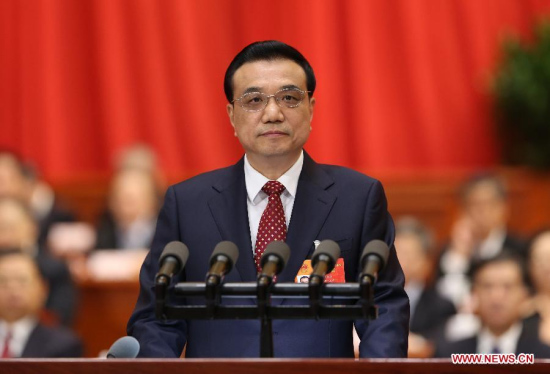

Chinese PremierLi Keqiang delivers the government work report during the opening meeting of the third session of China's 12th National People's Congress (NPC) at the Great Hall of the People in Beijing, capital of China, March 5, 2015. (Xinhua/Huang Jingwen)
As resource-related and environmental constraints grow and costs for labor and other factors of production rise, a model of development that draws on high levels of investment and energy consumption and is heavily driven by quantitative expansion becomes difficult to sustain, Li said.
"With downward pressure on China's economy building and deep-seated problems in development surfacing, the difficulties we are to encounter in the year ahead may be even more formidable than those of last year," he said.
A slew of disappointing data at the start of the year drew a gloomy picture.
The official factory activity purchasing manager's index (PMI) slumped below the boom-bust line for the first time in more than two years, while inflation dropped to a 5-year low and trade sank beyond expectations. Exports fell by 3.2 percent and imports plunged 19.7 percent for January.
Despite multiple analysis saying January's figures were incomplete because of the base effect of the Lunar New Year, which fell on Feb. 19 this year, considerable concerns remained.
The Chinese leadership has pinned much hope on more decisive reforms to overhaul China's economy and kick its addiction to rapid, investment and credit-fuelled growth.
The government's plans call for encouraging consumer spending and service businesses such as tourism, which are cleaner and could create more jobs than investment-intensive steel production and other heavy industry.
"We need to ensure every drop of spending builds to create a mighty river, so that the potential contained in an ocean of private consumers will be channeled into a powerful force driving economic growth," Li said.
Moreover, the government encourage emerging industries and new types of businesses, by raising more funds for promoting business development and innovation in addition to the 40 billion yuan government fund already in place.
It also plans to increase effective investment in public goods. In particular, the government will invest over 800 billion yuan in railway construction this year. Investment in the major water conservancy projects under construction will also exceed 800 billion yuan.
Ongoing land and residence registration reforms could also help boost China's urban population and allow its transition to a services- and consumption-driven economy.
Past measures are already paying off.
The National Bureau of Statistics (NBS) said in a statement earlier this year that the country's service sector represented 48.2 percent of China's gross domestic output (GDP) in 2014, up 1.3 percentage points from a year earlier.
The share of the industrial sector was 42.6 percent of GDP, while the agricultural sector accounted for 9.2 percent, the NBS said.
The contribution of final consumption to GDP growth is also 3 percentage points higher from a year earlier.
"We are already beginning to see the light at the end of the tunnel," said Xu Yaotong, a professor with the Chinese Academy of Governance when commenting on the figures.
Describing the current transition as a "painful" process, Xu said efforts must be made to eliminate outdated overcapacity while cultivating healthy development of emerging industries.
His words were echoed by Lu Feng, a professor with the Beijing University's National School of Development.
"Optimization of China's economic structure will become the country's 'new normal'," he said.
China to uphold WWII victory: premier
2015-03-05Premier Li warns ‘formidable difficulty‘ in 2015
2015-03-05Premier Li delivers gov‘t work report
2015-03-05China won‘t allow economy to nosedive
2015-03-05China unifies thinking to withstand cooling economy
2015-03-05China to reform investment, financing systems
2015-03-05Copyright ©1999-2018
Chinanews.com. All rights reserved.
Reproduction in whole or in part without permission is prohibited.